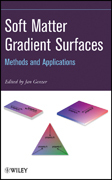
This book helps to bridge many soft material fields (materials science, chemistry, biomaterials) and introduces scientists not familiar with gradient substrates to new exciting opportunities for their work. Soft matter gradient surfaces have played a pivotal role in numerous aspects of materials research. Theyhave facilitated fast screening of physico-chemical phenomena, enabled fabrication of material structures that would have been difficult to manufacture otherwise, acted as recording media for monitoring a given physico-chemico-biological process, and played a key role in designing and fabricating surface-boundengines capable of acting as molecular and macromolecular motors and thus drove and/or directed a given transport phenomenon. Chapters will include fabrication, gradients in self-assembled monolayers, polymer gradients, dynamic gradient structures, applications in materials science, structure and assembly, mechanical properties, sensors, biomaterial applications, protein adsorption on gradient surfaces, and cells and microtubules on gradient surfaces. INDICE: Preface Jan Genzer Chapter 1. Gradient libraries: Harnessing a ubiquitous phenomenon to accelerate experimentation Michael J. Fasolka Chapter 2.Classification of key attributes of soft material gradients Jan Genzer and Rajendra R. Bhat Chapter 3. Discovery and optimization of sensing materials using discrete and gradient arrays Radislav A. Potyrailo Chapter 4. Colliding self-Assembly waves in organosilane monolayers Kirill Efimenko, Ali E. Özçam, Jan Genzer, Daniel A. Fischer, Fredrick R. Phelan, and Jack F. Douglas Chapter 5. Orientational anchoring of liquid crystals on surfaces presenting continuous gradients in composition Jugal K. Gupta, Kirill Efimenko, Daniel A. Fischer, Jan Genzer, and Nicholas L. Abbott Chapter 6. Continuous infusion microchannel approach to generate composition gradients from viscous polymer solutions Pratyay Basak, Pedro Zapata, Keith Reed, Ismael Gomez, J. Carson Meredith Chapter 7. Gradient assembly of complex surfaces for sensing, fabrication and high throughput analysis Andrew C. Hillier Chapter 8. Making gradient patterns by electron beam chemical lithography with monomolecular resists Nirmalya Ballav, Andreas Terfort, and Michael Zharnikov Chapter 9. Electrochemical mapping for polymer chemical and physical gradients Roger H. Terrill, Xuejun Wang, Paul W. Bohn Chapter 10. Directed assembly of block copolymer films: Effects of rough substrates and thermal fields Manish M. Kulkarni, Alamgir Karim, and Kevin G. Yager Chapter 11. Hydrogel gradients by self-initiated photografting and photopolymerization: Preparation, characterization and protein interactions Tobias Ekblad, Andréas Larsson and Bo Liedberg Chapter 12. Polymer gradients: Responsivegrafted layers Igor Luzinov and Sergiy Minko Chapter 13. Bioactive self assembled monolayer gradients Nicole M. Moore and Matthew L. Becker Chapter 14. Morphology gradients on different size scales, and their application in biological studies Christian Zink and Nicholas D. Spencer Chapter 15. Molecularly defined peptide spacing gradient for cell guidance Vera C. Hirschfeld-Warneken and Joachim P. Spatz Chapter 16. Motion of drops on gradient surfaces R. Shankar Subramanian
- ISBN: 978-0-470-52265-3
- Editorial: John Wiley & Sons
- Encuadernacion: Cartoné
- Páginas: 450
- Fecha Publicación: 17/02/2012
- Nº Volúmenes: 1
- Idioma: Inglés
